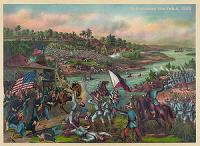Home | Military Conflict | Philippine-American War
|
|
|
Fighting erupted between U.S. and Philippine revolutionary forces on February 4, 1899, and quickly escalated into the 1899 Battle of Manila. On June 2, 1899, the First Philippine Republic officially declared war against the United States. The war officially ended on July 4, 1902. However, members of the Katipunan society continued to battle the American forces. Among them was General Macario Sacay, a veteran Katipunan member who assumed the presidency of the proclaimed Tagalog Republic, formed in 1902 after the capture of President Aguinaldo. Other groups, including the Moro people and Pulahanes, continued hostilities until their defeat at the Battle of Bud Bagsak on June 15, 1913. Opposition to the war inspired Mark Twain to found the Anti-Imperialist League on June 15, 1898. British poet Rudyard Kipling wrote The White Man's Burden, about colonialism. The war and occupation by the United States would change the cultural landscape of the islands, as the people dealt with an estimated 34,000 - 1,000,000 casualties, disestablishment of the Catholic Church as the state religion, and the introduction of the English language as the primary language of government and some businesses. In 1916, the United States granted the Philippines autonomy and promised eventual self-government, which came in 1934. In 1946, following World War II, the United States recognized Philippine Independence through the Treaty of Manila. |




 RSS
RSS










